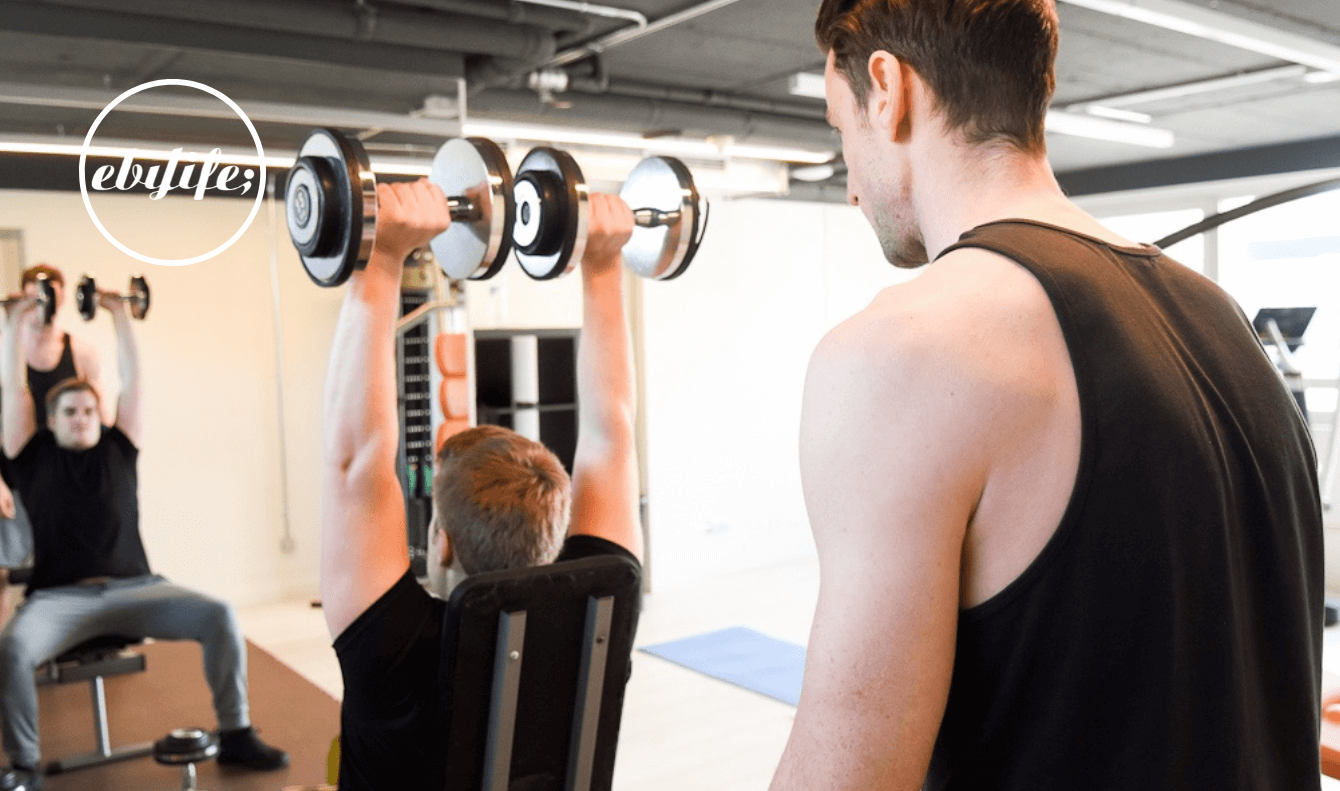Mastering the Gym: Why a Personalized Training Plan Is Your Key to Success
Written by Martin Ebner, Head Personal trainer and sports nutrition specialist at Ebylife.
You’ve decided that you want to join the gym but you aren’t sure where to start. You’re not alone. One of the main reasons people fail to implement a successful workout routine at the gym isn’t because they lack effort, it’s that they lack the know-how and proper planning.
Allow me to describe a very typical scenario. John Doe decides he’s going to start working out at the gym. He signs up, commits to a monthly payment plan, dusts off his workout gear, and decides that today is the day to get started on his journey toward a fitter and more muscular self. John arrives full of enthusiasm. He decides to kick things off with a quick warm-up on the elliptical, he then “does” some ab exercise that he saw on YouTube, attempts a few awkward squats, and then realizes that he has absolutely no idea what he’s doing. He awkwardly browses the gym floor looking at machines that more closely resemble torture devices than anything fitness-related. John decides that’s enough and calls it a day. Sound familiar? Unfortunately, this is the experience most people have when they first join the gym. Their intentions are always good but through a lack of planning, unrealistic goals, unattainable timeframes, low confidence and little know-how, most people give up after just a few weeks.
This article explores why having a personalized training plan and a trainer to help you implement it is paramount for newcomers to the gym.
Goal Setting
Setting clear and attainable fitness goals is the cornerstone of any successful fitness routine. Losing weight or gaining muscle is a great start but to excel, it’s best to set something a little more specific. For example: to gain x amount of muscle, primarily in your legs, core and back. Once you have a clear goal, you can begin to build a training plan specific to these goals.
I should emphasize the importance of setting attainable fitness goals here. We might want to look like Arnold Swartnegger (in his prime) or Beyonce (now) but it’s unrealistic because a.) well, we aren’t them! and b.) we unlikely have the time or energy required to get there. Chances are you have lifestyle factors and commitments that will impact how much energy and time you can put toward your fitness goals. It’s important to factor this in when building a training program.
Relate article: Why a slow and steady approach to your fitness goals always wins.
How to create a plan
Now that you have your goal(s), you need to decide how you’re going to achieve them. Here’s what you need to consider when building your training plan.
1. How much time do you have to put toward your fitness goals?
If you have a hectic job, a busy social life, and haven’t worked out in years or at all but think that you’ll be able to do 5 workouts a week from the get-go, think again. The body takes time to adapt to the physical demands of exercise. While I’m sure your intentions are great, it’s always better to start slow and build up as your body (and mind) adapt to your new training routine. Once a week every week for a year is better than 5 times per week for 1 month and then nothing at all for the rest of the year. Start with something you can maintain long-term. You can always add more as you go.
2. How long should your workouts be?
When it comes to strength training, I recommend keeping your workouts between 45-60 minutes. Any less and you may struggle to squeeze in enough volume. Any more and the quality of the exercise starts to diminish. It can also be a deterrent to motivation if your workouts are too long. Especially at the beginning.
3. Exercise selection
You have your goals, you have the amount of workouts you’ll do per week and roughly how long each workout will be. Now it’s time for exercise selection. Here are some general rules. Start with the basics. Opt for compound exercises (squats, lunges, deadlifts, pull-ups, push-ups, etc). Prioritise free weights and complement with machines. Leave the isolation work (abs, arms, calves, etc) for the end of your workouts.
4. Reps, sets, weight selection, rest times.
Once you’ve decided which exercises you’re going to do, you need to think about how many reps, sets and how much weight you’re going to use for each exercise. When starting a new program with a client, I generally recommend starting with 2-3 sets for 8-12 reps with around 60-90 seconds rest in between sets. Weight selection tends to take some trial and error. It’s better to start light and master the exercise before going heavier. Think quality over quantity. You want to be challenged but not repping out (performing repetitions of an exercise until muscle failure) too early into your program or workouts.
5. Length of your program
This is where a lot of people fail. They either think too short term or stick to the same workout routine for months or even years at a time. The former won’t produce results, the latter will lead to stagnation. As a general rule, stick to a program for 8-12 weeks or until you feel you can no longer progress from it. Once that happens, it’s time to change or modify your program.
The good news for newbies is that if you have a good plan and push yourself regularly, your rate of progression initially will be far greater than someone who has been exercising all their life.
6. Tracking Progress
Monitoring progress is a vital aspect of any training program. I’m not just talking about your weight or the size of your biceps. I’m talking about your workout volume and relevant notes. That means how many reps, sets, weights, exercise selection and order, form notes, etc.
To progress, you must progress. This is what’s referred to as progressive overload (gradually increasing the demands placed on the body over time to continually make progress). Whether that’s better from, more reps, sets, weight, shorter rest times etc. Keep track of it all. It will not only confirm that you’re progressing, but it’ll also offer you motivation to keep going.
Getting over gym fear and intimidation
I’ve been a trainer for over a decade and a regular gym user for over 20 years. If I’m honest, I still occasionally walk into a new gym and feel a little intimidated. Whether it’s a piece of equipment I’ve never seen before, a new layout, or even recently, I couldn’t work out how to use the lockers and that made me feel like a right plonker. Being new at something can unsettle us. However, if you can give it time, and allow yourself to be vulnerable, you’ll soon settle and find your way. Don’t be afraid to ask for help from fellow gym-goers. If they’re regulars, trust me, they’ll be happy to help.
Hiring a qualified Personal Trainer
The guidance and support of a good personal trainer can make a world of difference. I’ll emphasize the importance of the word good here. Unfortunately, there are a lot of so-called personal trainers out there and many of them aren’t particularly good at their job. Those that you find online or the first-time trainers at many commercial gyms tend to be average at best. Do a little research and find one that matches your vibe.
By employing a personal trainer, you’ll remove all of the guesswork. Not only will they be able to help you set realistic goals and build you an effective training program specific to your needs, they will also help you learn proper technique, show you what each piece of equipment is for at the gym, how to use them, offer accountability and you can treat them as an encyclopedia for everything from training to nutrition, to mindset and more. You can also use them as your gym “bodyguard” that will keep you safe and feeling comfortable as you get used to training at the gym.
Conclusion
Joining the gym is a big step. It’s also commendable and worthwhile if you can get over the initial discomfort of doing something new. Make it much easier on yourself by having a personalized training plan to follow. There’s very little worse for your progress or establishing a workout routine than not having clear objectives or knowing what you’re at the gym to do. Freestyling doesn’t EVER work.
If in doubt, employ a qualified personal trainer to build you a comprehensive training plan and to help you implement it at your local gym. By doing so you’ll 10x your chances of success.
Personalized training plans in Barcelona
At Ebylife We want to help you build and implement a successful training program. We know just how hard it can be. That’s why we now offer fully customised training plans at your gym of choice in Barcelona. We’re also English speaking so there’s no language barrier to get between you and bigger biceps or bum or both.
What we offer
We accompany you to your gym, we help you set goals, we build you a fully comprehensive training plan that includes exercises, reps, sets, weight, rest times and progressions, we show you how to effectively do each exercise with correct form, we show you how to use all of the equipment, we offer you as many sessions as you need to feel comfortable, settled and confident. We offer you check-ins and full support for the entirety of the training plan.
For more information get in touch with us today.
More articles you may be interested in:
Fit for You: The Complete Guide to Choosing the Right Gym
Best Gyms in Barcelona: A Comprehensive Guide for Every Fitness Enthusiast
Unlock Your Fitness Potential: The Power of Hiring a Personal Trainer
A hardgainers Guide to Building Muscle


